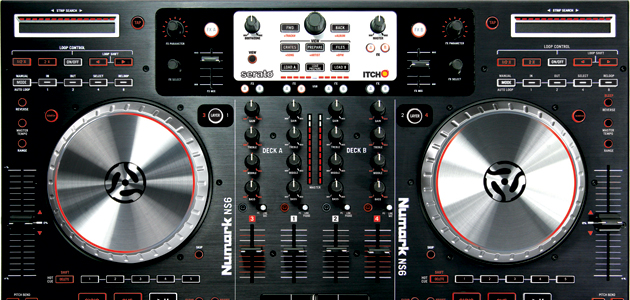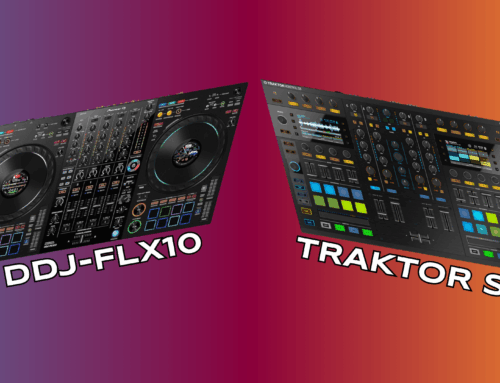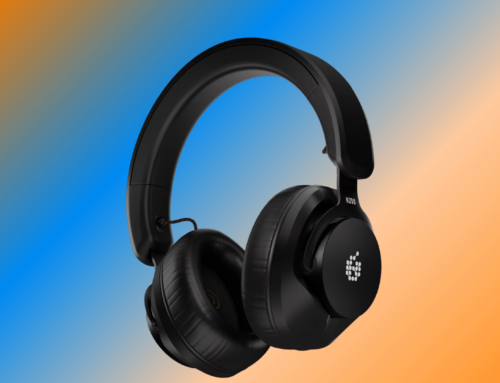 Competition among DJ controllers is really hotting up lately. From the cheap and highly portable, like Vestax’s Spin to Allen & Heath’s monstrous Xone:DX, every manufacturer even remotely engaged in DJ tech seems to have an offering for us these days. It’s a fast-moving scene, too, so despite the sheer volume of gear on the market, it feels like we’re still a long way from saturation. Innovation is strong, and it’s an exciting time to be a gear junkie.
Competition among DJ controllers is really hotting up lately. From the cheap and highly portable, like Vestax’s Spin to Allen & Heath’s monstrous Xone:DX, every manufacturer even remotely engaged in DJ tech seems to have an offering for us these days. It’s a fast-moving scene, too, so despite the sheer volume of gear on the market, it feels like we’re still a long way from saturation. Innovation is strong, and it’s an exciting time to be a gear junkie.
Numark’s history with hardware has been, well, not that inspiring, the odd flash of NS7-style brilliance notwithstanding. They’re stayers, though, and they don’t mind trying new things, so it was with restrained optimism that I greeted reports of a new high-end controller in the wings. I pictured something like their Mixtrack – functional and probably a bit too cute; fun and cool but hardly the kind of kit to give Pioneer a run for its money.
Boy, was I wrong.
The NS6 is a lot like the NS7, sans motorised platters (and heartbreaking price tag). It’s designed for, and is bundled with, Serato’s ITCH, which is currently enjoying its 2.0 release; it has the same black, white and red industrial pulchritude; and it’s every bit as well thought out and executed.
So let’s start from the top. The NS6 is split into four main sections: symmetrical decks at left and right, a four channel mixer in the centre and a combined effects and browser panel at the top. At the back are balanced XLR outs, RCA outs to master and booth, and separate stereo inputs for each of the four decks – two with line/phono and two with line/mic switches. The choice of RCA over 1/4” TRS jacks for these ins and outs is a shame, but in practice I have no gripes with the sound quality and this is one of very few disappointments. The front edge has 1/4” and 1/8” headphone jacks, cue level and balance knobs and a mono/stereo split cue switch, as well as controls for assigning each deck to crossfader left, right or neutral, a fader curve knob and independent fader start switches for the left and right sides. Pioneer’s DDJ series has the fader starts assigned to each upfader – this is aimed for you turntablists.

The faders themselves are free and fast and should keep just about everyone happy. The FX dry/wets are also faders, albeit tiny ones, and while I was hesitant at this blatant departure from orthodoxy, I’m now a total convert. Pushing effect intensity up and down turns out to feel far more intuitive than twirling a knob, and in another nice touch the effect’s on/off toggle sits just about the top of the fader, so cutting back to dry is just seamless.
The EQ knobs have an easy snap at centre and they’re noticeably more resistant than the gain and level knobs. The buttons – hard plastic – are solid and responsive, and just where they should be. And the platters! I wish I had more space to fawn over these touch sensitive beauties. They’re magnificent, far and away the best I’ve used in a controller. They’re silky smooth and at 3,600 ticks per revolution, they’re super high-res. At 7” you’re not going to mistake them for the real deal but you will get the next best thing: a platter so flawlessly built that you can forget all about it and concentrate on more important things.
The Scratch button does just what the name implies, changing the platter mode between scratch and nudge. I’m not much chop when it comes to scratching, but the combination of slick, high-res platters and that slippery crossfader, not to mention the videos doing the round, make it clear that the NS6 is aimed every bit as much at the turntablists as the house jockeys. That can be a treacherous temptation, so credit where it’s due – they’ve pulled it off.
Each deck has five hot cues that are, mercifully, as easy to clear as they are to store and trigger. Each has auto and manual loop controls with shortcuts to half and double the length, shift and reloop. The kinky Strip Search ribbon from the NS7 is here, too, and now it has a row of red LEDs across the top to give you instant feedback as to how far into the track you are.

Then there are the cool features. The Layer button switches between decks A and C on the left, and B and D on the right, and of course all the controls switch effortlessly with them. My favourite feature here is a tiny button labelled Skip. Hold this little nut down and wind through the platter while the level’s way up, and you’ll never skip a beat. That means you can jump from the intro to the chorus with a flick of the wrist and never have to worry about keeping time. It’s this kind of little touch that goes from curious nicety to second nature, and then onto standard feature, effortlessly.
Finally – though there’s so much more to say – the NS6 is designed for Serato’s ITCH, though it works perfectly in VDJ too. Traktor users aren’t so lucky: there are some TSIs starting to do the rounds, but there’s no sign of anything like “support” on the horizon, and given that the NS6 competes directly with NI’s S4, I’m not holding my breath. Shame – that would be an amazing toolkit.
You see, ITCH 2.0 is great, but it can’t go toe to toe with Traktor. The new features, which include some handy new view modes, new timing engine, smart crates and artwork support, have all been done before and don’t much close the gap between what is, essentially, a teaser for Serato’s real earner, Scratch Pro, and a mature, fully-featured DJ workhorse. That said, if you’re going to wring the last drop of musicality out of ITCH, this has got to be one of the best ways to do it.
Built like a tank and performing like your most trustworthy 1200s, the NS6 is a near-flawless triumph for Numark. It’s intelligent, well-constructed and it’s damn sexy. The whole effect is one of design insight and attention to detail: the people who made this thing really knew what they were about. We’ve already posted that it’s the new in-house controller for New York’s famous Juliet Supperclub, and I have a sneaking suspicion we’ll be seeing quite a bit more of this bad boy yet.





